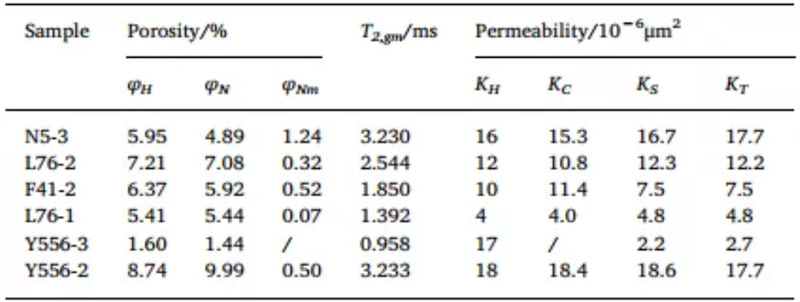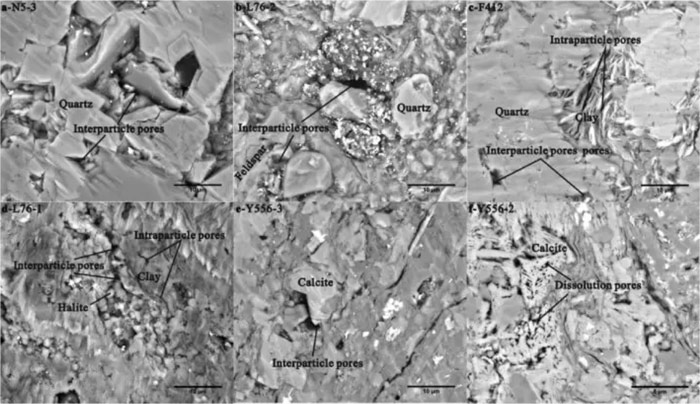Introduction·
NMR is sensitive to hydrogen-containing materials in porous media and is a non-destructive and effective method for characterizing the physical properties of rocks in oil-bearing reservoirs. Proton nuclear magnetic resonance information is mainly derived from the interaction between protons and magnetic fields, and contains two characteristic time decay constants: longitudinal relaxation time T1 and lateral relaxation time T2. Although rock physical properties and fluid characteristics were originally obtained from T1, T2 tests are now used because T2 tests are faster. Over the past two decades, nuclear magnetic resonance has been an important technique for revealing the physical properties (porosidad, permeabilidad, distribución del tamaño de los poros, mobile fluid content, etc.) of sandstone, carbonato, carbón, and other reservoirs.
As an oil source and reservoir rock, shale is a complex heterogeneous porous medium, rich in organic matter and clay minerals, and low in porosity and permeability. There are many ways to test shale pores, including mercury intrusion, adsorción de gas, (super) small-angle neutron scattering, scanning electron microscopy, and micro / nano CT. Most of the above methods have limitations:
For mercury intrusion, due to the compressibility of clay minerals and nanopores, excessive mercury injection pressure can distort the porous structure of the shale. Además, the pore shielding effect of small pores will result in a small pore volume estimation.
Gas adsorption can test shale pores smaller than 200nm, but it is necessary to destroy the sample into powder.
Microscopy techniques (scanning electron microscopy, Connecticut, and small-angle scattering) are limited by resolution and sample size and cannot eliminate the strong heterogeneity of the pore structure. Por lo tanto, in order to better characterize oil-bearing shale, a method that can systematically characterize the physical properties of complete shale samples is needed.
En años recientes, nuclear magnetic resonance has been considered as an effective choice to characterize shale, and has been used to study the physical properties of gas-bearing shales. Sin embargo, few people have studied the physical properties of oil-bearing shale by NMR. en este papel, two sets of low-field NMR experiments are performed on oil-bearing shales. The results prove that NMR has a strong applicability in characterizing shale porosity, permeabilidad, mobile fluid content, and pore size distribution. NMR is convenient, effective, and most importantly non-destructive, capable of testing pores ranging from nanometers to hundreds of microns. These advantages are important for both logging and laboratory analysis of shale oil development.
Métodos
A total of six massive oil-bearing shale samples were selected from four shale wells in Dongying oil well. The sample was cut into a 25mm diameter cylindrical rock core parallel to the bedding plane. For each core, helium was measured for porosity, permeabilidad, nuclear magnetic resonance and CT analysis. Al mismo tiempo, scanning electron microscopy, difracción de rayos X, total organic carbon content and rock pyrolysis analysis were performed on upper and lower cuttings.
Two sets of nuclear magnetic resonance tests were performed on the core: (1) 100% saturated kerosene conditions (Entonces); (2) residual kerosene conditions (Sir). All cores were first subjected to NMR tests in the So state, and then centrifuged to obtain the Sir state at a pressure differential of 2.76 MPA. The nuclear magnetic resonance uses the MicroMR 12-025V nuclear magnetic resonance core analyzer manufactured by Suzhou Niumag.
Shale sample characteristics
From the analysis of organic matter abundance, maturity, mineral composition, and porosity, the six samples differed greatly. The total organic carbon content of the six shales ranges from 0.16% a 2.62% (average 1.25%). The content of S1 is from 0.0941 mg / g to 1.0230 mg / gramo (average 0.3496 mg / gramo). The maturity of organic matter changes from low to high with the maximum pyrolysis hydrocarbon temperature from 437-487 ℃. The clay mineral content varies from 2.6% a 32.8% (average 23%), and the quartz content is between 43% y 19.8% (average 33.6%). The porosity of helium is 1.60% a 8.74%, with an average of 5.88%. The helium permeability is extremely low, menos que 100 × 10-6 μm2.
Mesa 1 Organic carbon content, pyrolysis rate and mineral composition of shale samples

Mesa 2 Porosity and permeability measured by nuclear magnetic resonance and helium

For the shale samples studied, intergranular pores, intragranular pores and dissolution pores of clay minerals were the most common pore types observed by scanning electron microscopy (Cifra 1).

Intergranular pores mainly exist between mineral particles, and their sizes vary within a wide range and are unevenly distributed. Clay mineral grains have long wedge-shaped or triangular inner pores, which mainly exist in the interlaminar of clay flakes between brittle minerals. Dissolution pores are irregular and uneven, resulting from diagenetic alteration of calcite or dolomite particles. En general, when the shale content is high, it is mainly intergranular pores. When the clay mineral content is high and the quartz content is low, the intergranular and intragranular pores of the clay mineral are mainly developed. Sin embargo, the pore abundance and type of calcareous shale mainly depend on diagenesis, and calcite (or dolomite) usually dissolves to form a large number of dissolution pores.
 mohoso
mohoso